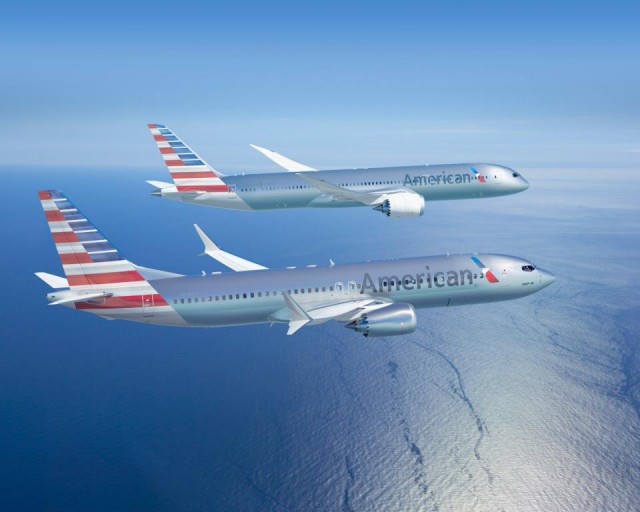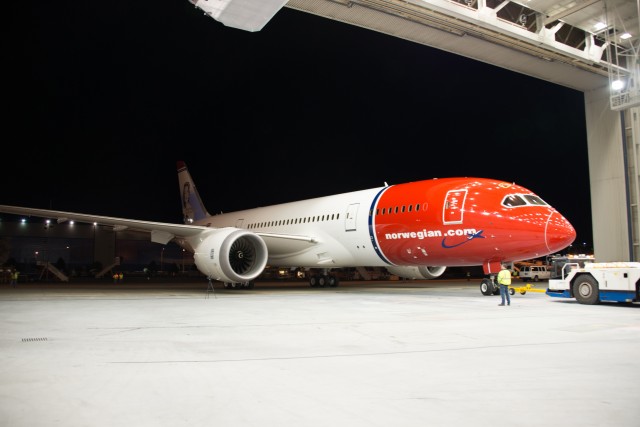
Norwegian Air’s first Boeing 787 Dreamliner. Image from Norwegian.
Last week, the first 787 destined for Norwegian Air rolled out of the Boeing paint hangar up at Paine Field (KPAE).
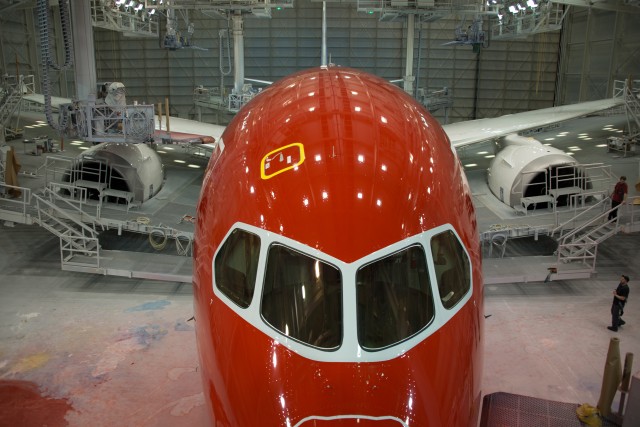
Wonder if anyone has called Norwegian’s livery Rudolph.
For those of you who attended this year’s Aviation Geek Fest may remember seeing line 102 on the factory tour in its white protective coating.
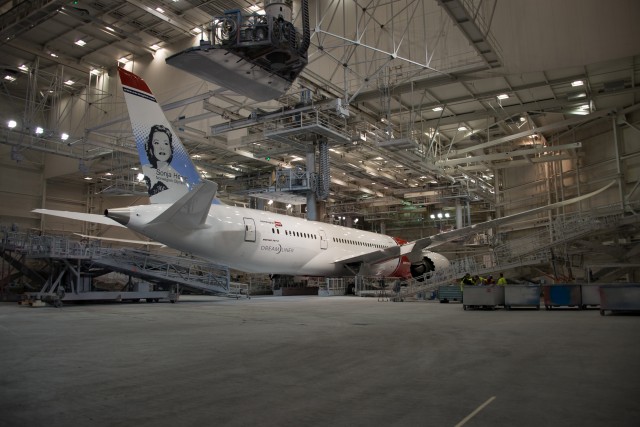
Norwegian Air’s first 787 Dreamliner.
The most striking and noticeable feature about this scheme is the fully painted red nose/front third of the aircraft, which for me looks very different compared to all of the white front halves that we have seen on every other 787 at this point. It’ll take a little to get used to but definitely is nice to see something a little different.
The tail, like on all of the airline’s 737s, features an important historic person that means something for the country.
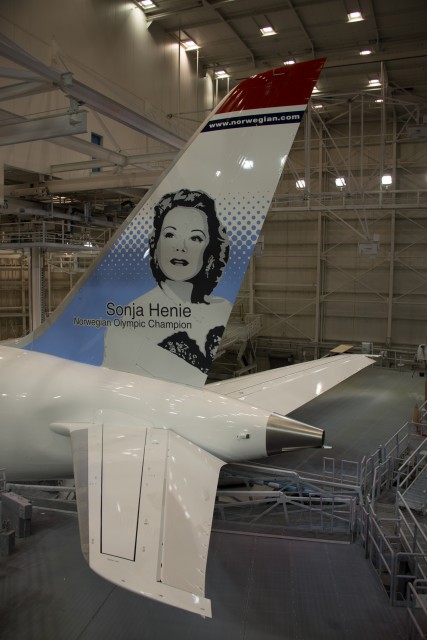
Sonja Henie was chosen to be on the airline’s first 787 Dreamliner.
Sonja Henie is featured on the tail of the first 787 and is a three time Olympic Champion and film star.
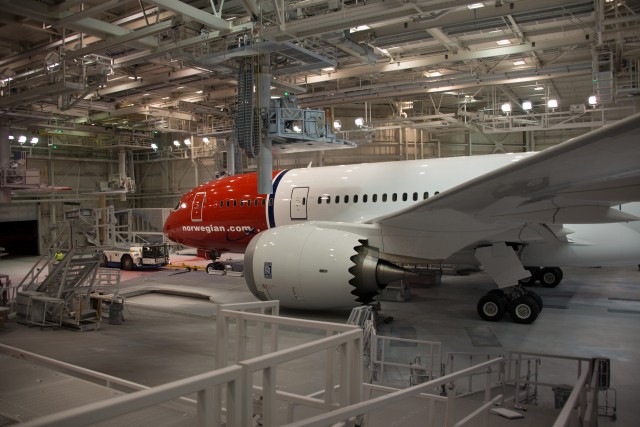
Side angle of Norwegian’s first Dreamliner.
So far this is easily one of the sharpest looking 787 schemes and will be the easiest one to pick out of a line up.
Due to the current woes facing the Dreamliner, it is uncertain when Norwegian will be taking delivery of their first plane.
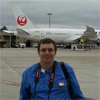 |
This story written by…Brandon Farris, Correspondent.
Brandon is an avid aviation geek based in Seattle. He got started in Photography and Reporting back in 2010. He loves to travel where ever he has to to cover the story and try to get the best darn shot possible.
@BrandonsBlog | RightStuffPhotography | Flickr |
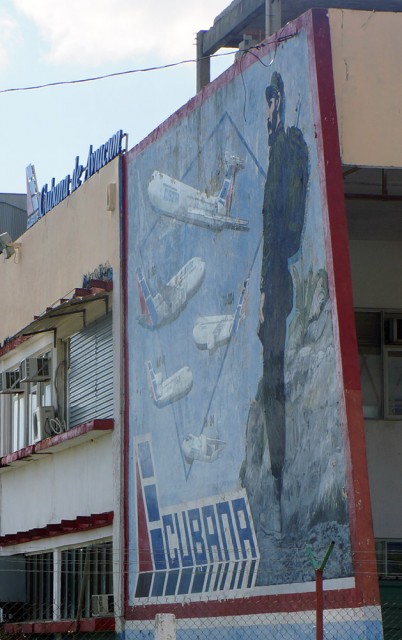
Fidel Castro, in full military garb, is painted posing with Cubana’s old Russian fleet in this mural on a wall of the airline’s maintenance base at HAV. Photo by Chris Sloan / Airchive.com.
This is an excerpt from Chris Sloan’s full story on Airchive.com:
For the first half of the 20th Century, particularly beginning during the U.S. Prohibition Era, Cuba was a playground for Americans where rum, gambling, and often-illicit activities flowed freely. Our closest Caribbean neighbor and ally to the South was also a major trading partner with the United States with many U.S. major multi-national companies having interests in sugar, farming, and tourism throughout the country. Havana, in particular was a sexy, and at times infamous place with exotic locales and attractions such as the Tropicana Night Club, Hotel Nacional, famed beaches, lively salsa music, and majestic old world architecture. The world-renowned hospitality, warmth, and exuberant personalities of the proud Cuban people were and remain an enduring feature of the nation. The mob and its iconic figures such as Meyer Lansky as well as Ernest Hemmingway’s books only enhanced Cuba’s sexiness and notoriety. It was in many ways ’œThe Las Vegas of the Caribbean’ before there was even the Las Vegas we know of today.
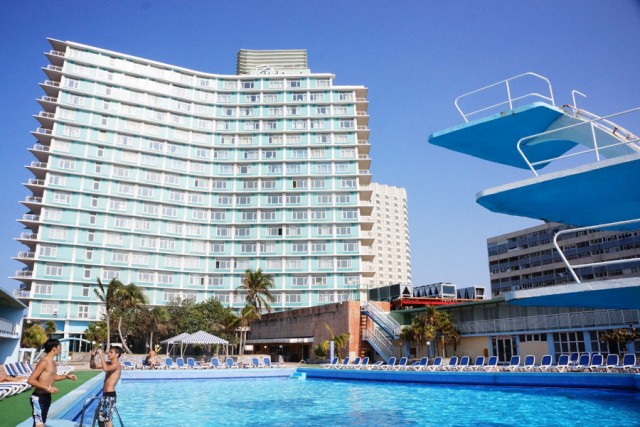
The Hotel Habana Riviera, or Havana Rivera as it is otherwise known, is located on the Malecón, looks virtually just as it did at the time of its 1957 opening. Overlooking the Gulf of Mexico, the Rivera was the first hotel in Cuba with air-conditioned rooms. After the revolution, it was taken over by the Cuban government and its casino was closed. This 350+ room hotel, remains one of the most perfectly preserved example of its kind in the world. Photo by Chris Sloan / Airchive.com.
Cuba and the United States had very close ties from the very beginning of aviation as well. Pan Am’s first flight was between Key West and Havana in 1929. Many other U.S. airlines spirited passengers, businessman, and cargo to Havana: Delta (via New Orleans), Braniff (via Houston), Pan Am (offering flights to Miami, Merida Mexico, San Salvador, and Jamaica), National (via Miami), Eastern (via Miami), and other smaller carriers such as Mackey (via Miami). Founded in 1930, Cuba’s national airline, Cubana, was once partially supported by Pan Am. CU frequently flew daily flights to Miami and New York Idyllwild first using DC-3s, DC-4s, Lockheed Constellations, Vickers jet-prop Viscount 318s and Bristol turbo-prop Britannia’s.
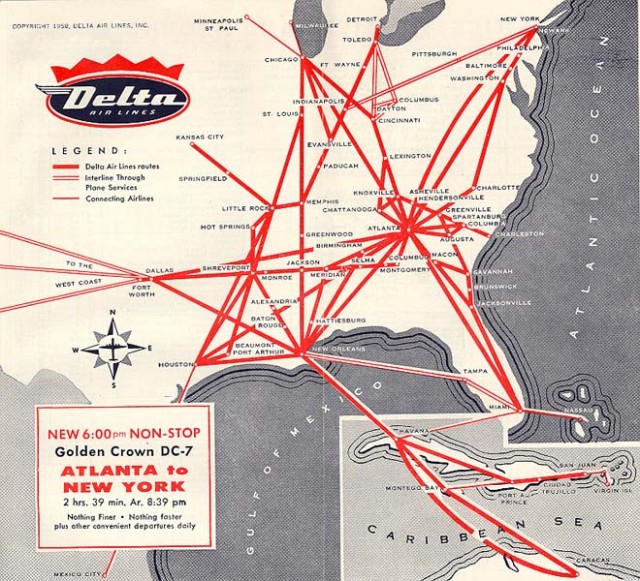
Delta served Havana and other cities in Cuba from New Orleans, its former Caribbean and Latin America gateway. Delta ended services to Cuba in 1961 under order of the U.S. government. Photo from Chris Sloan / Airchive.com.
For the citizens of Cuba, these were the best of times and the worst of times. Under an oppressive and corrupt dictatorship led by Batista who was supported by the American Government, there were a few ’œhave’s’ but many ’œhave not’s’. When Fidel Castro came to power on New Year’s Day 1959, many Cubans cheered at the prospect of change. No one really knew at the time just exactly what profound changes would come shortly to this remarkable country.
When the arguably even more brutal Castro regime began moving closer to Nikita Khrushchev and the Soviet Union during the Cold War, then nationalized all private businesses (including the foreign interests), and confiscated personal property, many Cubans and Americans fled the nation. Many felt at the time that this would be a short-term regime, not one that would be led by one of the longest lasting leader’s in modern history. Many Cubans sadly would lose everything they have and never return to their homeland again. Those that were fortunate enough to have survived the Castro regime, lost most of their personal property, businesses, homes, and especially their already limited freedom.
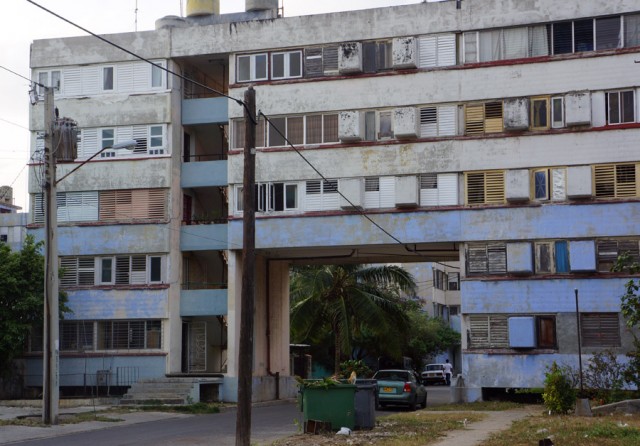
After the Revolution of 1959, American modernist and art-deco and Spanish inspired Mediterranean architecture was super-ceded by 1960s Soviet Eastern Bloc design. This ugly architecture, more at home in old East Berlin, Moscow, or Prague then the tropics is unfortunately ubiquitous throughout Havana. One can only hope that decay and new construction eventually means an end to these eyesores. Photo by Chris Sloan / Airchive.com.
The United States began limiting travel to Cuba shortly after the Revolution in 1959. Diplomatic relations were broken off in 1961, and following the Cuban Missile Crisis of October 1962 travel and trade restrictions were officially imposed under the Trading with the Enemy Act. An embargo on all business with the island Communist nation went into effect and has endured for 60 years.
Apart from humanitarian flights such as the Pedro Pan flights of the mid 1960s where children were allowed to leave Cuba for the United States; occasional relief flights, limited flights for Cubans to visit home, and a short time during the years under President Jimmy Carter when restrictions were loosened for educational, religious, and cultural exchanges were allowed, travel to the island nation has been virtually off limits. Following the often disastrous and tragic era of the Muriel Boatlift of 1980, President Ronald Reagan once again made travel to Cuba off-limits to most Americans in 1982.
For many, many years the only U.S. airlines operating to Cuba were those whose airplanes were hijacked ’“ a particularly frequent occurrence in the 1970s and early 1980s.
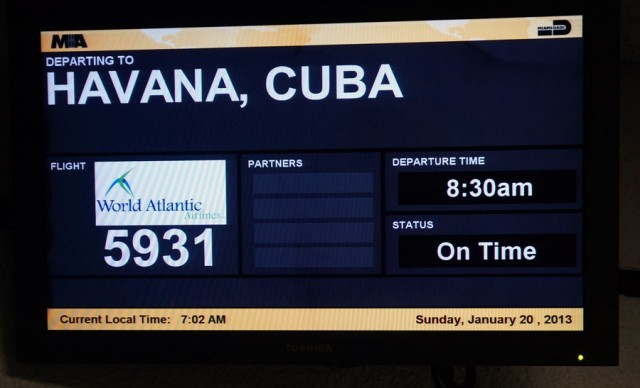
It’s not every day the Flight Information Screens display Havana Airport as a destination unless you’re at Miami International Airport. Photo by Chris Sloan / Airchive.com.
Technically it is not illegal for Americans to actually travel to Cuba, but the U.S. government prohibits its citizens from spending money in the country unless they fall into one of the groups with legal reasons to go there. Lured by the ’œforbidden fruit’ of Cuba, many Americans have illegally flown to Cuba via the Bahamas, Mexico, and Canada.
Those traveling illegally to Cuba run the risk of heavy fines and jail sentences through the Department of the Treasury. Though Cuba doesn’t stamp U.S. passports, there are many ways the United States government can detect travel to Cuba including access to airline’s reservation systems.

N802WA, a World Atlantic McDonnell Douglas MD-83, is the airplane we flew to Havana. It was built in 1990. Before flying for World Atlantic, the airplane flew for bankrupt Spanair. WAA’s Boeing MD-83 aircraft have a new interior and new configuration of 155 one class seats, providing with seat pitch ranging from 30’³ to 33’³. Photo by Chris Sloan / Airchive.com.
Cuban Americans visiting family are still the most frequent travelers between the United States and Cuba. In 2011, an estimated 400,000 Americans visited Cuba both legally and illegally, up from 250,000 in 2010. This is a surprisingly large portion of the 2.5 million annual visitors to Cuba. These are predominantly tourists from Canada and Europe who are drawn to this relatively inexpensive tropical paradise, with its wealth of culture, history, hospitality, and budding resort industry. Americans, however are barred from these resorts, and are discouraged from even visiting the beaches.
As a resident of Miami (sometime called Havana North), an aficionado of Cuban culture, a global wanderer and well, let me just say it ’œA Wandering Jew’, I had always had a fascination to visit this off-limits Island. When my synagogue Temple Beth Shalom in Miami Beach organized a humanitarian and cultural exchange trip, my wife and I leapt at the chance. The story of our 6-day trip to Cuba is one left to another post, and one difficult to put concisely into words.
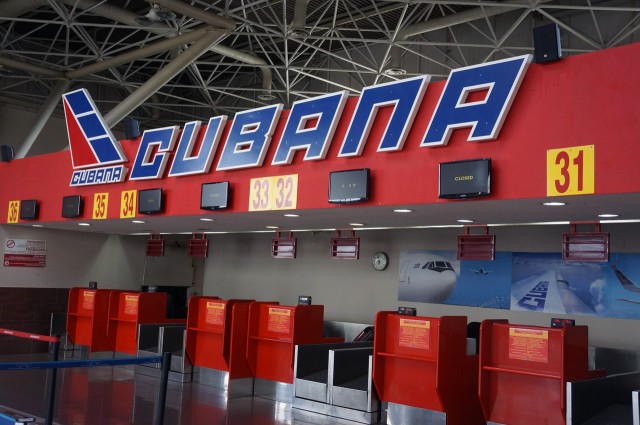
Unsurprisingly, Cubana dominates operations at Havana Jose Marti. Their ticketing takes up half of all space in Terminal 3, the newest at HAV. Photo by Chris Sloan / Airchive.com.
It is a bittersweet experience of paradoxes and contradictions. On one hand, it is fascinating and beautiful. On the other hand, it’s tragic, sad, and desperate. Two things stood out the most: Traveling to Cuba is indeed stepping back in time and not just because half the cars on the road are pre-1959 ’œDetroit Steel’. Second, the people in spite of all they have endured remain warm, and full of passion. We never once felt unsafe or unwelcome, except by 2 aggressive customs officer on the way out of the country.
Sixty minute private interrogations even if eventually communicated to me as ’œroutine’ are never fun, especially in a country that’s still a police state. But back to the positives, as an affirmed AvGeek, the experience of flying to Cuba nonstop from Miami and a visit to Jos Martà International Airport were of almost equal attraction in anticipation and in hindsight.
CONTINUE READING (MORE AWESOME AIRPLANE + CUBAN PHOTOS TOO) ON TRAVELING TO CUBA ON AIRCHIVE.COM
Other Good Cuban Stuff:
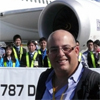 |
This story written by… Chris Sloan, Correspondent.
Chris has been an airline enthusiast, or #AvGeek, since he was 5 years old. Over the years, he has amassed an extensive collection of aviation memorabilia and photos that he shares on his site, Airchive.com. He is the President and Founder of the TV production and promotion company, 2CMedia.com and Executive Producer and Creator of ’œAirport 24/7’ Travel Channel series.
@Airchive | Airchive.com | Facebook |
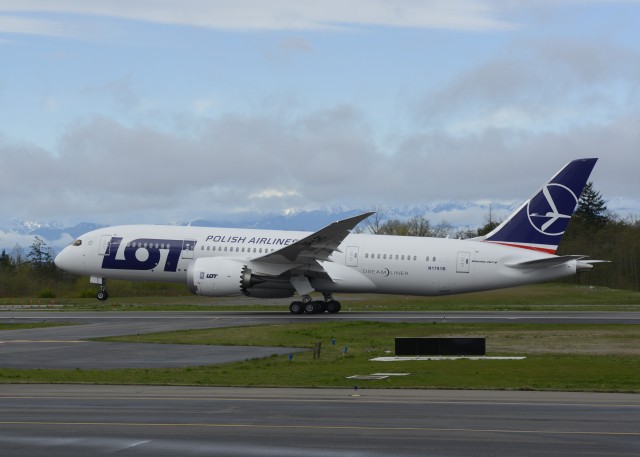
A Boeing 787 (L/N 86) painted in LOT livery takes off from Paine Field on April 5th. Image from Boeing.
On April 5th, Boeing conducted a test flight for the mostly grounded 787 Dreamliner. Line number 86, a Boeing owned 787 built for LOT Polish Airlines, departed Paine Field (PAE) for its first and final certification test for the new battery system. The airplane took off at 10:39 am Pacific Time and landed 1 hours, 49 minutes later at 12:28 p.m.
The 787 Dreamliner has been grounded since January 16th due to issues with the lithium-ion batteries that power the APU, but Boeing has been authorized to conduct a few test flights by the FAA, since the grounding.
“Our top priority is the integrity of our products and the safety of the passengers and crews who fly on them,” said Boeing Chairman, President and CEO Jim McNerney. “Our team has been working around the clock to understand the issues and develop a solution based on extensive analysis and testing following the events that occurred in January. Today’s approval from the FAA is a critical and welcome milestone toward getting the fleet flying again and continuing to deliver on the promise of the 787,” he said.
The test crew reported no negative issues and the data will be analyzed and submitted to the FAA. According to Boeing, once they deliver the data they will, “Stand ready to reply to additional requests and continue in dialog with the FAA to ensure we have met all of their expectations.”
When asked why Boeing chose L/N 86 with LOT livery for their test flights, Marc Birtel with Boeing Communications explained to AirlineReporter.com, “The airplane had already flown its first Boeing flight earlier this year and was already in the production flow toward delivery before the battery events occurred. As a result, we selected this airplane because of where it was at in the delivery process.”
According to the Seattle Times, the FAA could authorize the batteries as early as mid-month, but it would take a few additional months for them to start carrying passengers. Each of the 787s will need to be retrofitted and crews and employees will need to be re-trained.
Flight Global stated that fix teams have already been dispatched out to Narita, Japan to start modifying the 18 Dreamliners that are on the ground there as soon as they are given authorization. Along with the other ANA and JAL 787’s that are scattered around at different airports across the country. It is believed that it will take about four to five days to retrofit each aircraft.
It is expected that the Japan’s Civil Aviation Bureau (JCAB) (Japans version of the FAA), will follow the FAA’s decision to allow the Dreamliner to fly, whenever that might be.
UPDATE: Jaunted is reporting that United Airlines has the 787 back on their time schedule starting on May 31st. Also, Qatar is being a bit more optimistic and shooting for May 15th.
Brandon Farris and David Parker Brown contributed to this story.
[nggallery id=42]
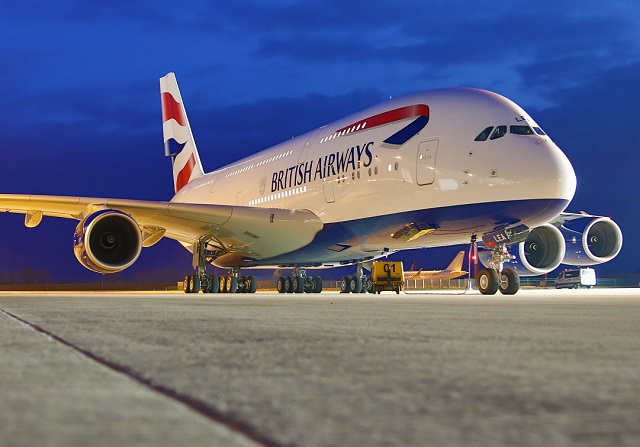
British Airways first Airbus A380 in Hamburg. Image from BA.
British Airways recently had their first Airbus A380 roll out of the paint hangar in Hamburg, Germany.
The airline is expecting to take delivery of their first double-decker airliner in July of this year and will first use the plane on short-haul routes for training and then on their London (LHR) to Los Angeles (LAX) route starting on October 15th. The second A380 will be placed on their LHR to Hong Kong in November (tickets for both flights are on sale now).
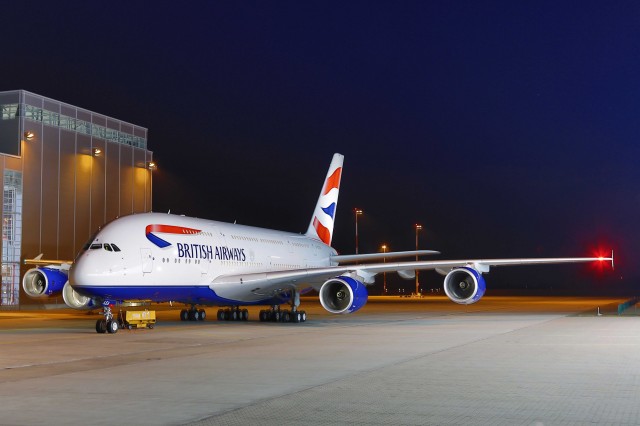
British Airways first Airbus A380 in Hamburg. Image from BA.
BA’s A380 will be configured to hold 469 passengers in four cabins: First Class (14), Club World (97), World Traveller Plus (55) and World Traveller (303).
The airline has 12 A380s on order, which are expected to all be delivered by 2016.
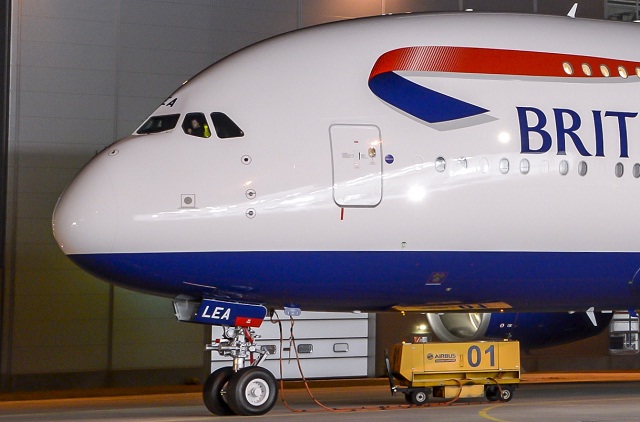
British Airways first Airbus A380 in Hamburg. Image from BA.
’œThis will be a very special premiere,” Keith Williams, British Airways’ chief executive, said. “The A380 is a great aircraft that has been developed with huge amounts of British engineering ingenuity. London and Los Angeles are two world-leading cities, and we are proud to be the first airline to connect them with the A380.’
Although the outside of the British Airways A380 is beautiful, the inside is not too shabby either:
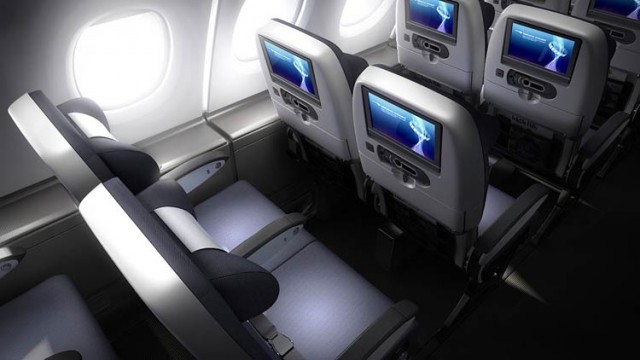
British Airways Airbus A380 World Traveller Cabin. Image by BA.
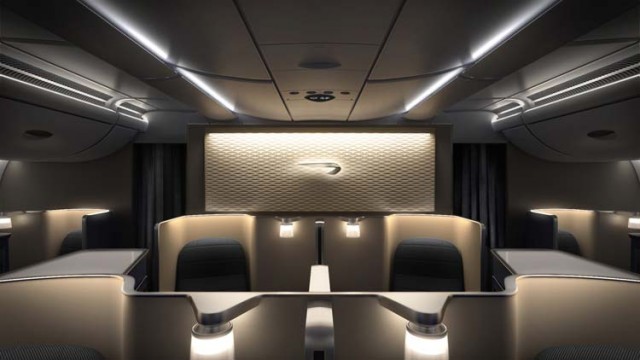
British Airways Airbus A380 First Class Cabin. Image from BA.
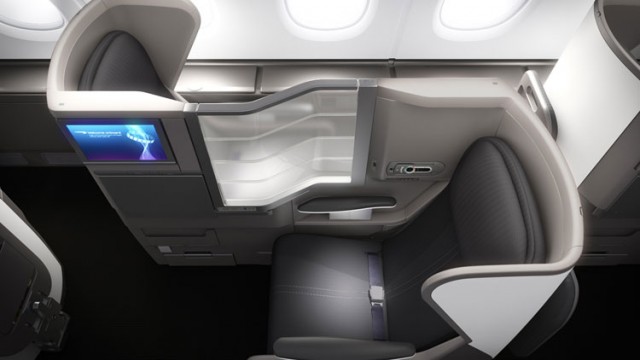
British Airways A380 Club World seat. Image from BA.
To learn and see more, check out British Airways special site on the Airbus A380.
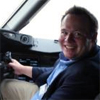 |
This story written by…David Parker Brown, Editor & Founder.David started AirlineReporter.com in the summer of 2008, but has had a passion for aviation since he was a kid. Born and raised in the Seattle area (where he is currently based) has surely had an influence and he couldn’t imagine living anywhere else in the world.
@AirlineReporter | Flickr | YouTube |














